How The Collie Dogs Rounded Up A Story
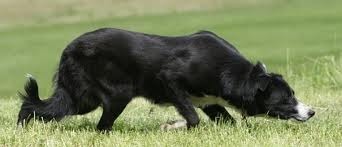
'Some years ago the late Miss Stewart Mackenzie of Brahan, Ross-shire, informed a friend that in the course of journeys by coach in the late autumn from Brahan to the South during her childhood about the year 1840 she used frequently to see collie dogs making their way north unaccompanied. On inquiring of her parents why these dogs were alone, [she] was informed that these were dogs belonging to drovers who had taken cattle to England and that when the droving was finished the drovers returned by boat to Scotland. To save the trouble and expense of their transport, the dogs were turned loose to find their own way north. It was explained that the dogs followed the route taken on the southward journey being fed at Inns or farms where the drove had 'stanced' and that in the following year when the drovers were again on the way south, they paid for the food given to the dogs...'I've more than once found inspiration in footnotes. The one above is taken from 'The Drove Roads of Scotland; by A. R. B. Haldane. I read it years ago - at least ten years ago. Those dogs were always trotting about at the edges of my mind.
Then they met up with the workhouse apprentices I'd read about thirty years ago. For centuries the apprentice system had put a boy to work for a craftsman. In return for his free labour, he recieved food, board and clothing, and a training in a trade.
With the industrial revolution, this system was corrupted to
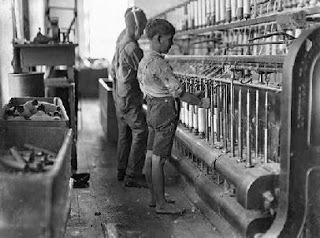 provide cheap labour for mills and factories. Pauper children were 'apprenticed' to the mills, where they were set to work for long, long hours in return for the cheapest food and clothing. They learned no skills, except the operation of machinery. At night they were locked up. They were, in everything but name, slaves. Their 'apprentice papers' bound them to the mill-owner until they came of age.
provide cheap labour for mills and factories. Pauper children were 'apprenticed' to the mills, where they were set to work for long, long hours in return for the cheapest food and clothing. They learned no skills, except the operation of machinery. At night they were locked up. They were, in everything but name, slaves. Their 'apprentice papers' bound them to the mill-owner until they came of age.What, I thought, if a child escaped from this slavery and, in running away, met up with a couple of collie dogs returning home to Scotland? The collies round him up, and as they provide protection and companionship, and he has nowhere else to go, he decides to walk with them wherever they take him. The dogs are heading west, to their home-croft on Mull, but the boy doesn't know that.
I found out my copy of Haldane's Drove Roads and consulted it. The drove route from the Isle of Mull to London was the one that seized my imagination. There were longer roads - cattle were, in historic fact, brought from the Outer Hebrides and driven down to London, but I decided not to tax modern readers' credulity.
My partner Davy, being a Scot of Highland descent, took a more than usual interest in this plotting. "It's too long," he said. "You've got to get them all that way. Why not keep it simple and have the dogs on their way back from the market at Falkirk?"
I don't always take his advice - it's his constant complaint - but on this occasion, I listened. 'Keep it simple, stupid,' is a good rule of thumb.
But if the boy was walking from somewhere near Falkirk to Mull, the dates wouldn't work too well for him being an escapee from factory enslavement.
When I said this, Davy told me what he knew about Scotland's 'bond-women' who wore an odd 17th century costume, and were 'bonded' to work on farms right into the early 20th century. Sometimes boys were bonded too, and it was a pretty harsh system. Davy told me of a boy he'd read of who'd been over-worked, under-fed, and made to sleep in a damp shed with thistles growing through his pillow. He'd escaped his bond by enlisting in the army when WWI broke out - and while everyone around him thought barracks life was harsh and the rations short, the bond-boy had never known such luxury in his life.
So there's my boy, walking west with the dogs, following the drove road out of English speaking Lowland Scotland, into Gaelic-speaking Highland Scotland. I don't know a word of Gaelic. I don't know much about Scots history - nor, unfortunately, do I know a man who does. Davy says, 'They don't teach English history in Scots schools, and when they taught Scots history, I wasn't listening.' Why does my imagination never give me anything easy to do?
But at least, thanks to Haldane, I know the route he and the dogs would have taken - and last week, Davy and I were up in Scotland, checking it out. And getting bitten by midgies (Davy) and by cleggs (me.)
We went to the old ferry crossing on Loch Awe, where the drovers took their cattle across.
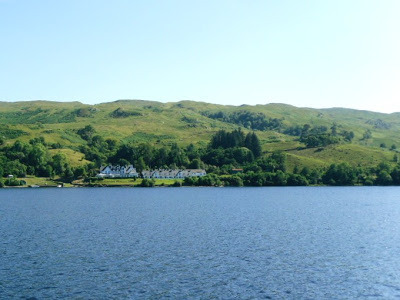 This is taken from Taychreggan. The building is a modern hotel, but it's situated where the old droving inn stood. The drovers took their cattle across here, and then climbed the hills beyond, heading for Loch Fyne. The modern hotels here are pretty swish and exclusive. They take some finding for one thing. It's not casual passing trade they're relying on. The thronged drovers' inns were about as unlike them as it's possible to be. Dr. Johnson gave them terrible reviews on his equivalent of TripAdvisor. They were, according to him, damp, dirty, flea-ridden and with filthy food. But as the drovers lived on oatmeal mixed with water, milk and blood, their taste was robust. From Taychreggan, as Davy was feeling strong, we took the road less travelled, via Glen Nant and Glen Lonan, to the town of Oban. So we came in over the hills, as the drovers would have done. The journey was beautiful, but only for drivers of strong nerve. The sheep don't help, as they lie in the road, toasting their little trotters on the hot tarmac, and giving not a spit for tourists in cars. The mountains - ('Hills,' Davy says, 'they're hills.') - the mountains rose above us and leaned over, peering down like giants. It gave me a vivid feeling of how my wee boy would feel, lost in that landscape, and how glad he would be of the dogs' company. The Highlands were more populated then, with many crofting communities. Even so, it would have been no walk through a park. Here's Oban.
This is taken from Taychreggan. The building is a modern hotel, but it's situated where the old droving inn stood. The drovers took their cattle across here, and then climbed the hills beyond, heading for Loch Fyne. The modern hotels here are pretty swish and exclusive. They take some finding for one thing. It's not casual passing trade they're relying on. The thronged drovers' inns were about as unlike them as it's possible to be. Dr. Johnson gave them terrible reviews on his equivalent of TripAdvisor. They were, according to him, damp, dirty, flea-ridden and with filthy food. But as the drovers lived on oatmeal mixed with water, milk and blood, their taste was robust. From Taychreggan, as Davy was feeling strong, we took the road less travelled, via Glen Nant and Glen Lonan, to the town of Oban. So we came in over the hills, as the drovers would have done. The journey was beautiful, but only for drivers of strong nerve. The sheep don't help, as they lie in the road, toasting their little trotters on the hot tarmac, and giving not a spit for tourists in cars. The mountains - ('Hills,' Davy says, 'they're hills.') - the mountains rose above us and leaned over, peering down like giants. It gave me a vivid feeling of how my wee boy would feel, lost in that landscape, and how glad he would be of the dogs' company. The Highlands were more populated then, with many crofting communities. Even so, it would have been no walk through a park. Here's Oban.
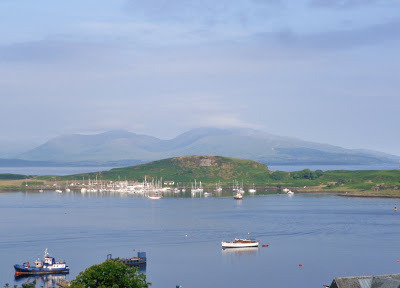
The green island in the foreground is Kerrara, which safeguards Oban's harbour.Rising up behind it are the mountains of Mull. It's quite hard to imagine Oban as it would have been at the turn of the 18th-19th century. The whisky distillery - one of the oldest - would have been there, and the castle, obviously. Over on Mull, we visited Grass Point, which is where the cattle and drovers left the island. The cattle were taken by boat over to Kerrara, walked the length of this small island, and then swum across the narrow strait to Oban. We tried to pin-point where this was, and decided that it must have been near where the castle stands.
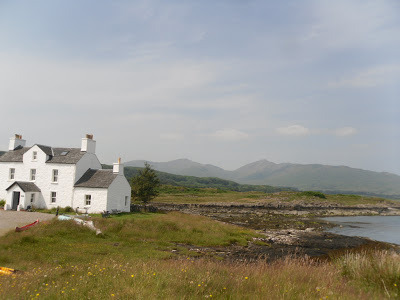
Here's the old ferry house at Grasspoint on Mull - today it's another remote place to stay on holiday. If you like holidays where the only night-life is provided by midgies. We ended here, on Iona, so Davy could walk in the footsteps of the great Scottish colourist, Cadell.
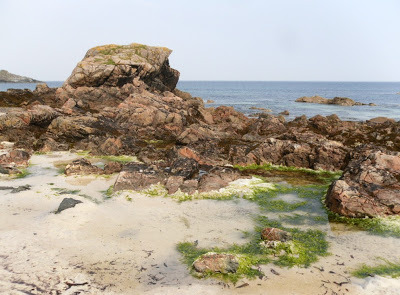
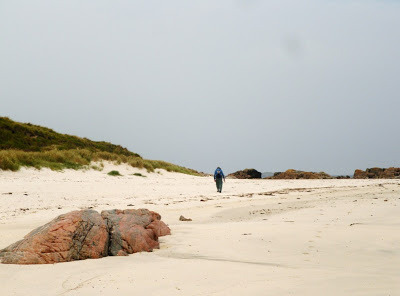
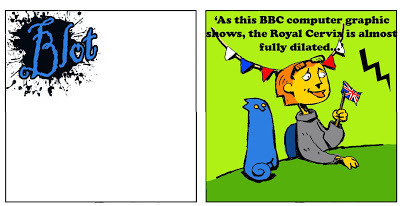
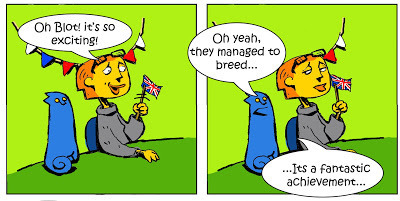
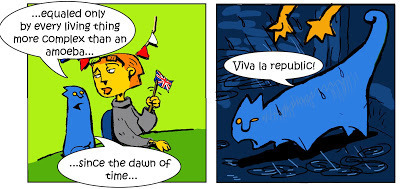
I am entirely with Blott. If he comes round to mine, he can have Republican sanctuary with a warm dry cushion and cream.
Published on July 26, 2013 16:05
No comments have been added yet.
Susan Price's Nennius Blog
"I have made a little heap of all I've found..."
"I have made a little heap of all I've found..."
...more
- Susan Price's profile
- 71 followers



